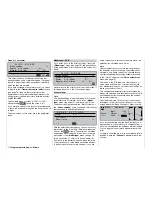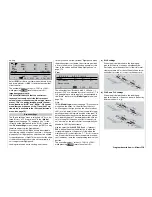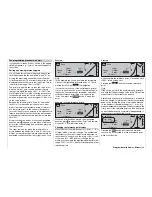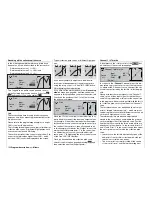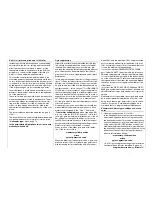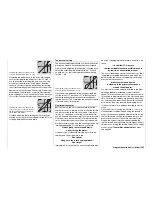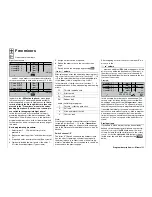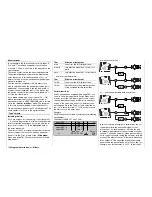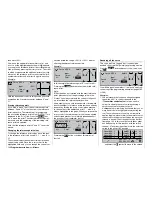
127
Program description:
Mixers
Roll
tail rotor and pitch-axis
tail rotor
Increasing collective pitch requires a corresponding
adjustment to the tail rotor setting, and the same ap-
plies if a major cyclic command is given i. e. if the
swashplate is tilted in any direction. In the
mx
-24s
program you can adjust the degree of throttle follo-
wing for roll-axis and pitch-axis separately.
This function can eliminate a problem which is en-
countered primarily in extreme aerobatics which invol-
ve very large control defl ections in the pitch-axis cont-
rol system, e. g. the “Bo-turn” (vertical pull-up followed
by tipping over around the pitch-axis) and tight loops.
If the torque changes are not corrected by a mixer,
the model tends to rotate around its vertical axis to a
greater or lesser extent, and this spoils the appearan-
ce of the manoeuvre.
These two mixers provide static torque compensation
when the swashplate is tilted in any direction. The mi-
xers work by always increasing tail rotor thrust, star-
ting from the centre point of the roll and pitch-axis
sticks, i. e. they always affect tail rotor pitch in the
same direction regardless of the direction of the com-
mand.
The mixer value can be varied within the range 0 to
+100%.
The mixer direction is automatically determined when
you defi ne the direction of main rotor rotation in the
»
Helicopter type
« menu, page 72.
In the auto-rotation fl ight phase this mixer is auto-
matically switched off.
Gyro suppression
Right at the outset we should mention that this func-
tion should not and must not be used if your model
is fi tted with a modern gyro system. However, ple-
ase read the operating instructions supplied with your
gyro. This menu has been retained so that the pro-
gram can still cater for all requirements and all pilots’
preferences.
In this program segment the effect of the gyro sensor
(“gyro”) can be varied according to the tail rotor stick
position; this assumes the use of a gyro system who-
se gain can be controlled from the transmitter via an
auxiliary channel – this is channel 7 for
GRAUPNER/
JR
mc
radio control systems. The gyro suppression
function reduces gyro gain in a linear progression as
the pilot increases the tail rotor defl ection; the rate of
suppression is controlled by the mixer value you have
set. Without gyro suppression, i. e. a mixer value of
0%, the gyro effect is constant, regardless of the tail
rotor stick position.
However, gyro gain can be varied proportionally bet-
ween minimum and maximum by means of a trans-
mitter control assigned to the “Gyro 7” line in the
»
Transmitter control adjust
« menu (see page 80),
e. g. one of the two INC / DEC buttons 5 or 6. In this
case gyro gain is maximum at full defl ection of the sli-
der, and zero at the opposite end-point. Of course,
the
mx
-24s software allows you to limit the range of
gyro gain adjustment by altering the setting for trans-
mitter control travel to both sides of neutral.
At any position of the slider, gyro gain at full defl ec-
tion of the tail rotor stick is:
“momentary slider position
minus
gyro suppression value”.
When the slider is at the neutral position, a gyro sup-
pression value of 100% will reduce gyro gain to zero
with increasing tail rotor defl ection, and a value bet-
ween 100% and the maximum 199% suppresses the
gyro completely, well before full defl ection of the tail
rotor, according to the position of the transmitter cont-
rol; see the diagram on the next page.
If you are using the
GRAUPNER/JR
NEJ-120 BB
gyro, Order No.
3277
, the bottom and top values are
adjusted using separate rotary potentiometers: adjus-
tor 1 sets the
minimum gyro gain in the bottom positi-
on
of the slider; adjustor 2 sets the
maximum gain at
the top end-point
of the slider; the transition between
these two values occurs roughly in the middle of the
slider travel.
In contrast, the PIEZO 900, PIEZO 2000 and PIEZO
3000 gyro systems feature proportional, infi nitely vari-
able adjustment of gyro gain; see below for typical di-
agrams.
An example of using variable (static) gyro gain would
be to exploit maximum stabilisation for normal, slow
fl ying, but to reduce gyro gain for fast circuits and ae-
robatics. If you wish to use different settings, we re-
commend that you program different fl ight phases.
Examples of different gyro settings and set-up
notes
1. Linear gyro suppression: 0% to 199%
In the centre position of the tail rotor stick the gyro
effect which applies is that set using the associa-
ted transmitter control. This can be varied proporti-
onally between zero (“min”) and maximum (“max”)
using one of the INC / DEC buttons or one of the
side-mounted proportional controls, provided that
the transmitter control travel is not restricted. At full
defl ection of the tail rotor stick the effective gyro
effect is calculated as follows:
“momentary slider position
minus
gyro suppression value”.
i. e. at 0% gyro suppression the gyro gain remains
constant when a tail rotor command is given; at
Summary of Contents for mx-24s
Page 1: ...1...
Page 19: ...19 For your notes...
Page 35: ...35 For your notes...
Page 41: ...41 41 For your notes...
Page 57: ...57 For your notes...
Page 63: ...63 63 For your notes...
Page 69: ...69 69 For your notes...
Page 85: ...85 85 For your notes...
Page 99: ...99 For your notes...
Page 143: ...143 For your notes...
Page 191: ...191 For your notes...
Page 212: ...212 212 For your notes...
Page 213: ...213 213 For your notes...
Page 214: ...214 For your notes...
Page 216: ...216...


